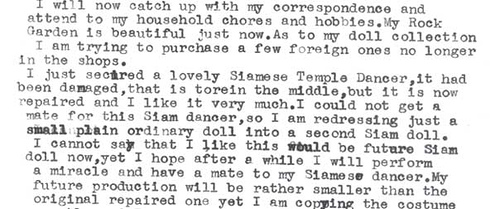In 1911, three murderers were hanged on Greenberry Hill, London.
Their names were Green, Berry, and Hill.
In 1911, three murderers were hanged on Greenberry Hill, London.
Their names were Green, Berry, and Hill.
cynoclept
n. one who steals dogs
In 1898, Columbus prison inmate Charles Justice helped build and install Ohio’s only electric chair.
Justice finished his sentence and returned to society, but irony caught up with him. Thirteen years later he was back in prison, and on Nov. 9, 1911, he was executed in the same electric chair he had helped to build.

Looks pretty innocuous, right? This is part of a letter composed by New York doll shop owner Velvalee Dickinson in May 1942. The FBI decoded it as follows:
I just secured information on an aircraft carrier warship. It had been damaged, that is, torpedoed in the middle. But it is now repaired. … They could not get a mate for this, so a plain ordinary warship is being converted into a second aircraft carrier. …
Probably she was referring to the aircraft carrier U.S.S. Saratoga. Apparently Dickinson had been operating as a Japanese spy throughout the war — her letters to Buenos Aires, ostensibly about doll collecting, had actually contained detailed information about U.S. warships, coastal defenses, and repair operations.
She protested her innocence but got the maximum sentence, 10 years and a $10,000 fine. She died in 1980.
The Mad Gasser of Mattoon was a mysterious figure who haunted Mattoon, Ill., in the summer of 1944.
Typically, homeowners would report awakening to a sweet odor, then feeling nausea, dizziness, headaches, breathing difficulty, or a feeling of paralysis. Some saw a tall figure dressed in black fleeing their property after the attack.
Police and citizens patrolled the streets, and the newspapers printed several sensational accounts, but the police never found a suspect. The attacks stopped after Sept. 13, as mysteriously as they had begun.

Wander too far away from the World’s Columbian Exposition of 1893 and you might disappear forever.
Herman Mudgett, an enterprising serial killer, built a row of three-story buildings near the Chicago fair and opened it as a hotel. Guests discovered — too late — that it was a maze of more than 100 windowless rooms, where Mudgett would trap them, torture them in a soundproof chamber, and then asphyxiate them with a custom-fitted gas line.
Then he’d send the bodies by chute to the basement, where he’d cremate them or sell them to a medical school.
This went on for three years, until a fire broke out and police and firemen discovered the trap. No one knows how many people Mudgett killed; he confessed to 27, but estimates go as high as 230.
He was hanged in Philadelphia in 1896.
In 1963, Peter Reyn-Bardt killed his wife and buried her in a peat bog in Cheshire County, England. Twenty years later, when a body was discovered, he assumed he’d been caught and turned himself in.
He should have waited. An investigation showed that the body was not his wife’s, but that of an Iron Age man who had died two thousand years earlier and been eerily preserved in the cold acid bog.
They convicted Reyn-Bardt anyway.

Vatican City has the highest per capita crime rate of any nation on earth.
Former Argentine president Juan Perón is buried in Buenos Aires. In 1987, someone broke into his tomb and stole his hands.
No one knows why.
“I don’t even know what street Canada is on.” — Al Capone